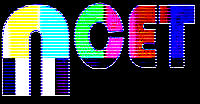The following is Bill Roarty's brief description of the working situation at NCET, and is excerpted from a longer series of documents at www.o-art.org:
~~~~
[Bill] Roarty...describe[s] a typical day at the center (KQED), which at that time was in one huge room: [the 1011 Bryant Street, KQED studio]
~~~~ Warner [Jepson] and I would be working on a complex sound composition and immediately to our left would be Stephen [Beck], designing a circuit and then on the other side of that would be Bill Gwin, looking at a tape, and over there would be Willard [Rosenquist], working on light forms. You couldn't help but be completely excited by the thoughts and perceptions of all the people around you approaching things each in his own way.
The center entered a highly productive period in the spring of 1972. Don Hallock, Bill Gwin, Willard Rosenquist, and Bill Roarty all produced some of their most beautiful tapes. (Some of these tapes will be discussed in the third section of this report.)
In the fall, Warner Jepson and Stephen Beck embarked on a concert tour around the country, giving performances with their audio and video synthesizers, respectively.
This burst of activity continued into the summer of 1973, when Don Hallock presented his "Videola" at the San Francisco Art Museum.
|

